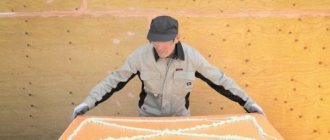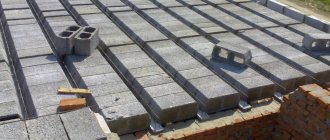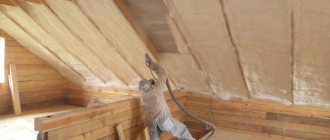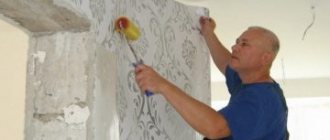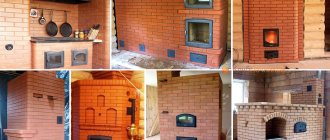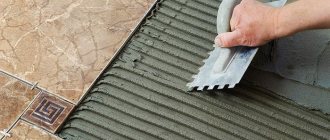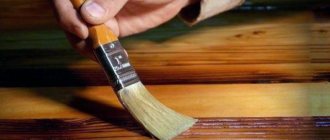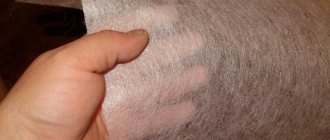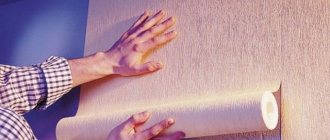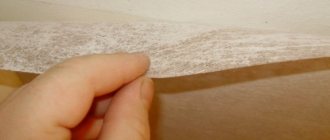About five years ago, foam adhesive for expanded polystyrene (EPS) appeared in construction stores. It ensures strong adhesion of materials. Manufacturers promise that this tool is convenient to use even without the help of specialists.
- Purpose
- Specifications
- Advantages
- Flaws
- Differences between polystyrene foam and polystyrene foam
- Adhesive foam for polystyrene foam: brands
- TechnoNIKOL
- Akfix 960
- Makroflex MF 901
- Ceresit CT 84
- Tytan Styro 753
- Foam adhesive consumption for polystyrene foam
- Application technique
- Storage rules
Professional builders are familiar with this adhesive composition. And for those who do not know what it is for and how to use it, the article discusses:
- purpose of the remedy;
- specifications;
- advantages and disadvantages;
- popular brands TechnoNIKOL, Makroflex and others;
- application technique;
- consumption, storage rules.
Purpose
This is a composition with a limited scope of application, it is not universal. It was developed for securing slabs made of extruded polystyrene foam. Compatible with standard PPS.
This type of adhesive is used to secure the slab to the bases when installing thermal insulation systems. Some mixtures can be used for all types of work, some of them can only be used for external or internal work. Adhesive foam is used to install thermal insulation of building foundations, roofs, basements, floors, and walls.
What's wrong with it
Even if you follow all the technology requirements and these tips, it is difficult to avoid the disadvantages of using polyurethane foam.
Gluing foam takes much longer and requires more labor.
A gradual increase in the volume of foam that continues after application leads to deformation of the sheets, uneven surfaces, and the formation of gaps.
Repeated application increases the consumption of the adhesive base.
When choosing foam for installation, evaluate the advantages and disadvantages of each, including ease of use and cost.
Insulating a house with polystyrene foam places high demands on the compounds used. The adhesive and binding element must ensure good adhesion (adhesive strength) and durability of use, and the application technology must ensure the selected foam.
For reviews of attaching polystyrene foam to foam, watch the video:
Specifications
To understand the functions of the tool, you will need to study its technical characteristics. The basis of the composition is polyurethane, a polymer with increased adhesion.
It is convenient to work with adhesive foam. It is resistant to water and moisture. Economical, sets quickly. Therefore, the insulation of facades takes place in a short time. Such compositions are resistant to temperature changes and have good heat-insulating properties.
Advantages
One package will be enough to treat ten square meters of surface. The master does not need to prepare the composition by stirring the components or diluting it with water. It is already ready for use.
Other benefits:
- After application, the adhesive seam almost does not change its shape and does not expand.
- Applying foam is convenient and easy. It will not be difficult to remove excess material. To do this, use paint solvents or a special cleaner, which is offered by many manufacturers of polyurethane foam.
- Primary setting occurs in 1-2 hours. Complete hardening of the composition will be completed within 24 hours.
- The resulting seams will be strong and reliable.
These factors are the opposite of most other adhesives. They need more time to harden, which leads to an increase in finishing time.
Flaws
Compared to similar products, mounting adhesive foams are sold at higher prices. This composition must be applied with a professional glue gun, which is not included in the kit, so you will need to purchase it separately.
However, not all manufacturers produce products that meet all the declared qualities. Therefore, first we recommend that you study the reviews of specialists about working with products from specific brands on the Internet.
What are the advantages of using foam in the case of penoplex?
Penoplex is used as a soundproofing material, and polyurethane foam is used to blow in the seams between the plates. At the same time, it qualitatively seals the seam. Another useful function offered by foam is gluing the foam board to surfaces, even vertical ones.
Even an inexperienced builder can do this kind of work. The slabs are glued unnoticed, however, the penoplex is securely fixed and they proceed to the next stage.
Application of foam with penoplex
Using this product instead of glue will help save money, applying the foam is much easier and requires less time to dry completely than glue. The use of foam is in no way inferior to specialized glue in terms of adhesive properties. Why do they buy it to simultaneously use it both for gluing penoplex and for blowing in seams and joints.
Differences between polystyrene foam and polystyrene foam
Foam adhesive for polystyrene foam and compositions for polystyrene foam have differences in structure. Foam plastic is foamed plastic. There are dozens of types of plastic, therefore there are also many subtypes of foam.
Every foamed plastic is foam plastic, and polystyrene foam is its subtype. Sometimes in construction stores they can be passed off as the same material, but this is wrong. Builders, on the contrary, urge to distinguish them by separate names. Yes, they are similar in appearance, but they differ in structure and properties. Therefore, different adhesive foams are needed for such materials.
Conclusion
As you can see, choosing glue for penoplex is not a problem now. I talked about those compositions that I encountered myself, but besides them there are many other worthy compositions. If you still have questions, write in the comments, I will try to help.
"Penoplex" is currently considered one of the highest quality slab insulation materials.
Author: Olga Bilovitskaya · Published 11/22/2018 · Updated 11/25/2018
Penoplex is a building material that is used for insulation and thermal insulation of various surfaces and rooms. To fix the slabs to the bases, special adhesives are used, which are available in a wide range. To ensure long-term quality and reliability of the material, you need to know how to choose the right adhesive for penoplex among the existing variety.
Adhesive foam for polystyrene foam: brands
Builders consider the best products to be those made in Germany or France. In second place are Polish, Turkish, and Estonian manufacturers.
Experts advise giving up cheap Chinese products. Such products cannot effectively cope with their functions. We recommend choosing trusted brands.
TechnoNIKOL
TechnoNIKOL foam adhesive is a universal polyurethane composition for external and internal insulation of buildings. It is characterized by mold resistance and high adhesion to most materials.
Glue 500 PROFESSIONAL interacts well with PPS. It provides strong adhesion and strength to the seam. According to reviews from craftsmen, it copes with polystyrene foam better than other compounds.
Akfix 960
A one-component composition made in Turkey based on polyurethane, which is often found in building materials stores. Suitable for both expanded polystyrene and foam.
It is used for installation of thermal insulation of building facades. Sold in 900 ml bottles. It is moisture resistant, so it can be used in conditions of high humidity.
The consumption of adhesive foam is economical; one package is enough for several jobs. They can be carried out at air temperatures from -10°C to +30°C and humidity not exceeding 60%.
A professional gun is required for application. Before this, the surfaces must be cleaned of dust, dirt, grease and oil residues. Akfix 960 can be used for external work with materials based on mineral binders:
- brickwork;
- concrete, gypsum panels and slabs.
Makroflex MF 901
Makroflex MF 901 adhesive foam is a means for rapid gluing. Can be used for external and internal work. Macroflex interacts with metal, ceramics, wood, stone, glass, and foam. You can work with it in hot weather.
It is better not to use at sub-zero temperatures. The pre-treated surface must be cleaned, otherwise the gluing will be poor quality.
Ceresit CT 84
Ceresit CT 84 Express adhesive foam for PPS is often found in construction and hardware stores. It is produced in 850 ml cylinders. It is characterized by good adhesion, reasonable price, and ease of application.
Designed for installation on bases made of mineral binders:
- PPS slabs and sealing joints between them;
- Thermal insulation systems on the outside of new buildings and during the reconstruction of existing ones.
It is necessary to work with it at air and base temperatures from -10 to +40 degrees Celsius. Post-processing of the slabs can be carried out within two hours after gluing them. This is possible provided the outside air temperature is from -10°C and its humidity is not lower than 60%.
Tytan Styro 753
This is a mounting foam adhesive from a Polish manufacturer, blue in color, without shrinkage. Titan Stiro 753 is sold in cylinders with a volume of 750 milliliters.
It sets quickly, within an hour. It will take half a day to completely harden. It tolerates humidity, cold and heat well, so the adhesive is used for installing expanded polystyrene and polystyrene boards on building facades. One cylinder is designed to work with 10 square meters of surface.
How to apply foam and how to work with penoplex
To fix penoplex sheets to the surface, using polyurethane foam as glue, apply it around the perimeter of the sheet and in the center. If a pistol is used in the work, it is better to minimize the supply of the substance. If you use a regular household cylinder, then apply foam quickly. Next, the penoplex is pressed against the surface and held in this position for several minutes. Then start attaching the next sheet. Pre-prepare the sheets - trim them for ease of installation.
The installation of the slabs is carried out in a checkerboard pattern, from bottom to top - this minimizes the gaps between them.
Next, start filling the gaps. If the distance between the sheets is large, then fill it with small wedges from the foam itself. If you use foam, it will cause cracks. Carefully blow out small cracks, not forgetting to hold the already fixed sheets. Do not overdo it; excess moves the sheet and disrupts its fixation. Remove what comes out.
Finished work
It is better to use foam when laying penoplex on the floor. When sheets are attached to the wall, glue is preferred. A specialized substance will provide more guarantees of high-quality fixation, although there have been no obvious complaints from builders regarding the foam. Many people use polyurethane foam instead of glue and no negative consequences have been noticed.
Foam adhesive consumption for polystyrene foam
Before work, the technician needs to make sure that the purchased product is enough for the entire scope of repairs. To do this, you need to study the packaging and find information about the consumption, which depends on the weight of the bases being glued.
For example, TechnoNIKOL foam adhesive has a higher concentration of active ingredients: 600 grams in a 750-milliliter container. Therefore, on average, one cylinder will be enough to cover 10 to 12 square meters of surface.
Experts advise making a preliminary calculation of consumption in order to stock up on the required number of cylinders of one brand. Don’t risk buying products from other brands later, because each manufacturer has its own quality of sizing.
When everything in life sticks - installation of building materials with foam glue in 60 seconds
For advertising purposes
House construction and renovation work are lengthy processes. In addition, the installation of drywall, tiles, polystyrene foam, OSB boards, aerated concrete partitions and other building elements requires a professional approach. Fortunately, most technologies that have significant shortcomings are beginning to lose their relevance. This includes the use of dry adhesive mixtures, which have a lot of disadvantages:
- Heavy weight, limiting use for high-altitude work.
- Long-term complete setting (28 days).
- Dustiness when preparing the solution.
- Quite a big expense.
- Difficult to use at low temperatures.
- The need to purchase a significant amount of equipment for preparing the mixture.
- Experience in preparation and application is required.
Gluing is quick and easy - it's possible
Innovative technologies are changing our understanding of building a house and renovating it. Now anyone can quickly and efficiently carry out installation work using foam glue. This does not require special training or professional equipment. There is no need to waste time mixing the adhesive and setting it. The entire amount of work can be completed in just a few minutes.
"Tytan Professional 60 Seconds": what is it?
Thanks to its many years of experience in the field of construction, Selena launches the innovative foam adhesive product “Tytan Professional 60 Seconds” on the market. It is stated that foam adhesive has undeniable advantages over dry mixtures and has nothing in common in its characteristics compared to polyurethane foam. Is it so? Let's check. It is “Tytan Professional 60 Seconds” that has TYTACK technology, which is responsible for the initial adhesion; after 60 seconds (unlike other foam adhesives), the stability of the glued elements on vertical and horizontal surfaces is ensured, so there is no need to stand and hold the glued element when Moreover, with this technology, the correction time is 5 minutes.
For example, you need to insulate the ceiling of a loggia; to do this, you need to apply this foam adhesive to the thermal insulation material, wait 60 seconds and glue it to the ceiling; no additional holding of the insulation is required.
Unlike conventional polyurethane foam, this product has no secondary expansion and has an adhesion to concrete of 500 kg/dm2.
Foam adhesive "Tytan Professional 60 Seconds" is a universal product and is suitable for most building materials and applications:
How to work correctly with “Tytan Professional 60 Seconds”?
Working with foam glue “Tytan Professional 60 Seconds” is very simple and you don’t need to be a professional.
Additional equipment requires a foam gun, which is screwed onto the cylinder. After this, the container is shaken and a path of glue with a diameter of 2-3 cm is applied to the mounted element. If, for example, you are making a partition from aerated concrete, then it can already be plastered after 2 hours.
Advantages of "Tytan Professional 60 Seconds" - the basis of a strong connection
- Sticks in a minute. There is no need to make any effort to support the glued element; it will not slide off the vertical surface.
- Universal, suitable for drywall, aerated concrete, and other building materials.
- Easy to install. Even a beginner can install the necessary elements.
- Convenient to use: minimal weight, compact dimensions, easy storage.
- Characterized by high adhesion to concrete: 500 kg/dm2.
- Economical: the consumption of one cylinder is equivalent to the consumption of a 25 kg bag of dry mixture. One bottle of glue is 40 linear meters of glue track.
- No primer required: saves time and money.
- The only additional equipment required is a pistol, which can be easily purchased at any store.
- Complete curing time is 24 hours.
Application technique
TechnoNIKOL foam adhesive and other brands of such compounds must be used in strict compliance with the manufacturer’s instructions. To work correctly with such tools, they follow the following algorithm:
- pre-clean the surface from dirt and grease;
- put a nozzle gun on the glue bottle;
- foam adhesive for polystyrene foam is applied evenly (try to maintain the thinness of the layer required for gluing);
- then the glued part is placed on the surface with the material and pressed with force to secure it;
- the processed parts are left to harden for the time specified in the manufacturer’s instructions;
- It will take at least 1.5-2 days for the adhesive foam to completely harden.
Operating procedure
Work is best carried out in calm, warm weather.
To thoroughly adhere polystyrene foam insulation, clean the surface to the material of the insulated surface. Set the starting bar strictly horizontally.
Its width is equal to the thickness of the sheet used. Remove dust by rinsing or sweeping. Prime the wall using a roller or brush. Treat the surface of the foam with a needle roller to improve contact with the adhesive.
Sticking foam is carried out in the following sequence:
- prepare the cylinder for use according to the instructions for use;
- screw the cylinder onto the gun, avoiding distortions;
- apply foam to the treated surface of the slab along the perimeter in a continuous strip about 3 cm high, then in the middle along the long side (the distance from the edge to the layer is at least 20 mm);
- install the stove in its designated place;
- if necessary, adjust its position, checking it using a long building level or rule;
- carry out subsequent stacking of sheets from bottom to top;
- Fill the resulting joints with foam;
- After 30 minutes, cut off the excess that appears with a construction knife.
To adjust the position of the sheet, the same polystyrene foam is used. Use a gun to pierce the foam and pump in the adhesive composition. The leaf retains its relative mobility for 10-20 minutes.
The use of adhesive foam makes installation work as easy as possible. The work can be carried out by one person, both on the surface of the earth and at height.
We use an inexpensive analogue
If there is a lack of funds, you can attach polystyrene foam to polyurethane foam. In order to reduce its consumption, install the insulation using a gun.
When choosing polyurethane foam for penoplex, polystyrene foam and other polystyrene foams, pay attention to its components. It should not contain toluene, alcohols, solvents, or other substances that lead to destruction of the structure.
The procedure for preparing the surface and applying the mixture to the slab does not change. Before gluing the foam, the wall must be moistened with water. Brick and concrete – generously, wooden – lightly.
There are some small peculiarities of fastening penoplex and polystyrene foam with polyurethane foam. They are due to the low speed of gaining the required density. When used in the same manner as adhesive foam, the slabs will need to be held in place for a long time (from 40 minutes to an hour). But this can be avoided.
After applying the composition, apply it to the surface for 3-5 seconds and shake the slab from side to side. Tear it off. Re-apply the mixture to it in a volume equal to half of the required amount. Wet the foam with water from a spray bottle.
Let the process of hardening and gaining density begin. The operating time will take from 2 to 4 minutes (during this time, prepare for the next installation). Then place the plate in place and press it firmly for 10 seconds. You can attach the next one.
This use case will significantly speed up the work process and eliminate the need to use supports and spacers.
Application technology
In fact, there is nothing complicated in the process of attaching polystyrene foam using special adhesive foam. After all, it was designed to simplify this process.
Adhesive foam is applied to the foam board along the perimeter, with one clear tape
But we will still outline the algorithm of work and take into account several interesting nuances that may affect the result.
It is important to understand that the installation technology does not differ depending on the choice of the adhesive foam itself for attaching polystyrene foam. That is, AKFIX 960 foam will be applied in exactly the same way as Ceresit C-84 adhesive foam.
There are, of course, certain differences, but they relate rather to the technical side of the issue, without affecting the general process.
For example, AKFIX 960 cools faster than Ceresit, and therefore, after application, the slabs will also have to be glued more quickly. But again, even here the difference will be completely insignificant. The point is about differences in a matter of minutes, nothing more.
Stages of work:
- We clean the surface of the polystyrene foam from dirt and dust.
- Clean the base. If the base quickly absorbs moisture, prime it.
- We load the cylinder into the gun.
- Apply foam around the perimeter of the slab.
- Apply another strip of foam in the center of the slab.
- We glue the slab in the right place.
- Let's correct its position.
- We lay the remaining slabs.
- We blow out the joints between them with glue foam.
- Cut off the remaining hardened foam with a knife.
- After 20 minutes you can still trim the slab.
- After 2 hours, the foam has completely cooled and you can begin further processes, for example, drilling dowels or applying the first layer of plaster.
After use, the gun must be washed. Moreover, this is done both mechanically and with the help of special cleaning compounds.
Let us remind you that you can buy polystyrene foam in Orel at a favorable price.
Mechanical cleaning consists of cutting off excess foam from the supply tube, and chemical cleaning is carried out using cylinders with cleaning liquid. They are connected to the gun and the barrel of the instrument is pumped at maximum pressure until it completely leaks.
